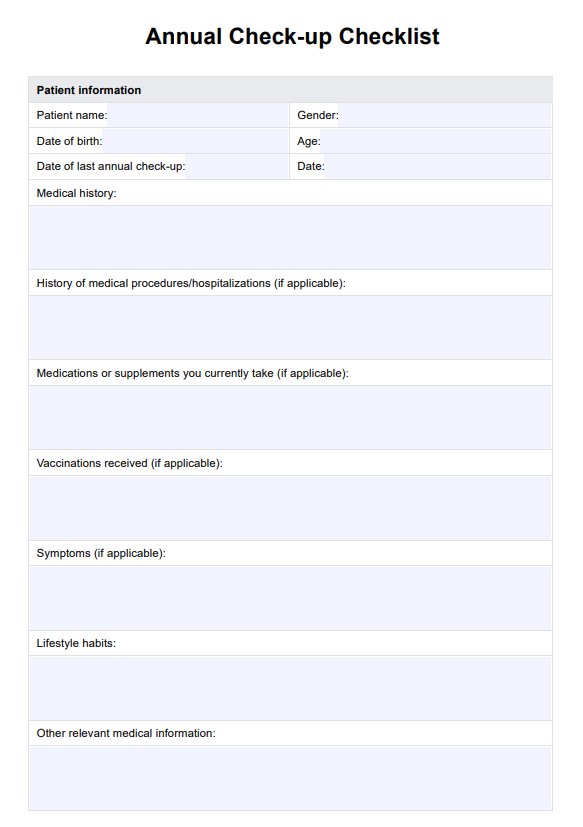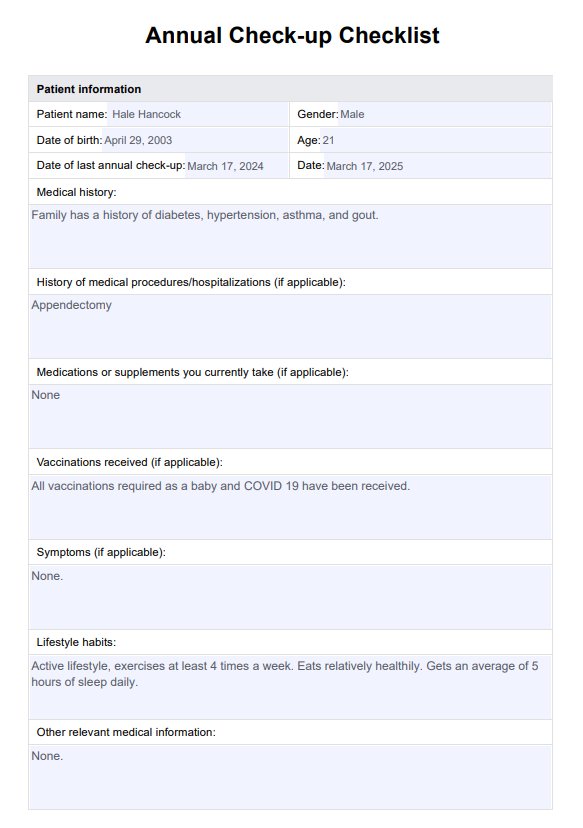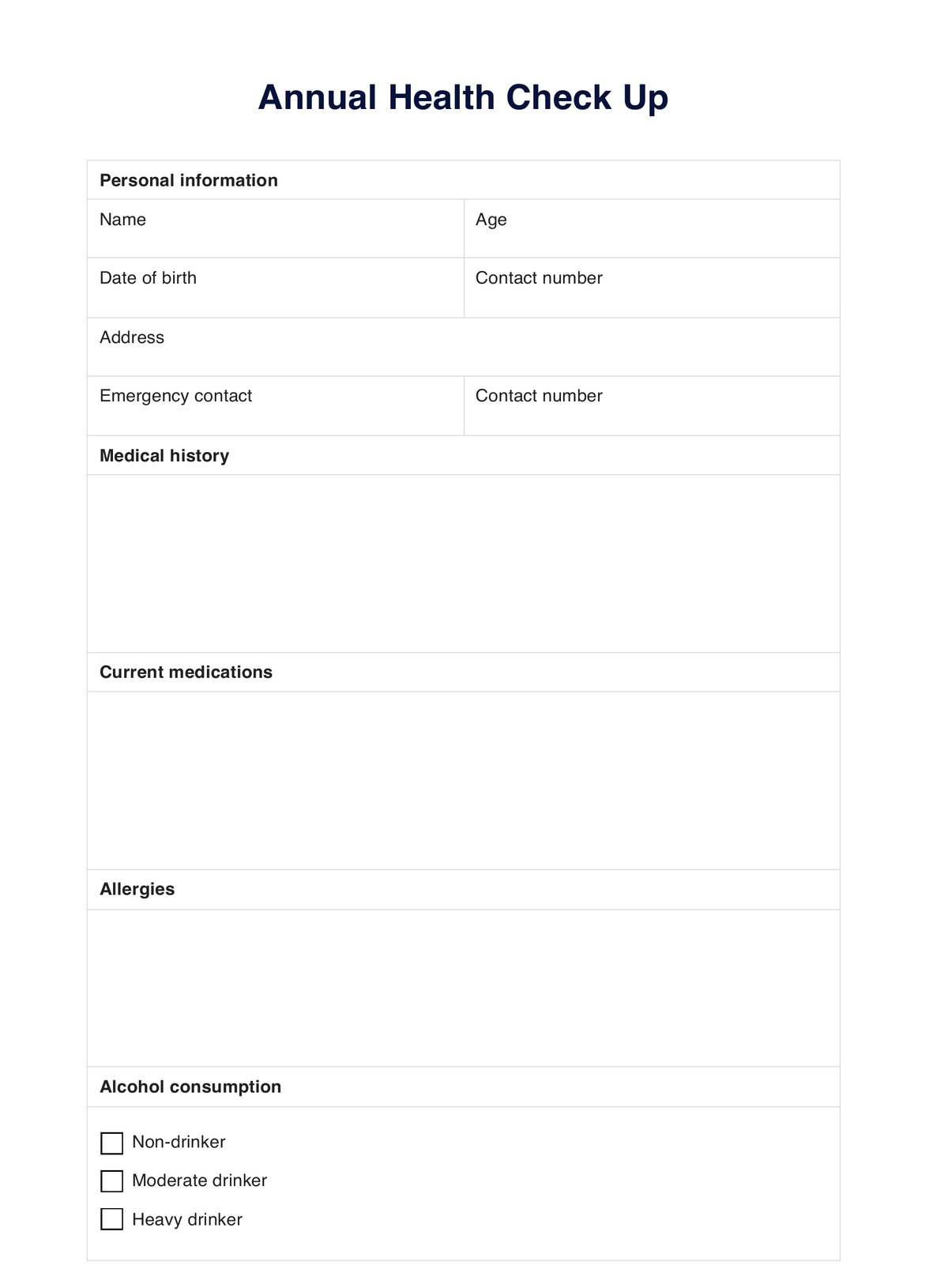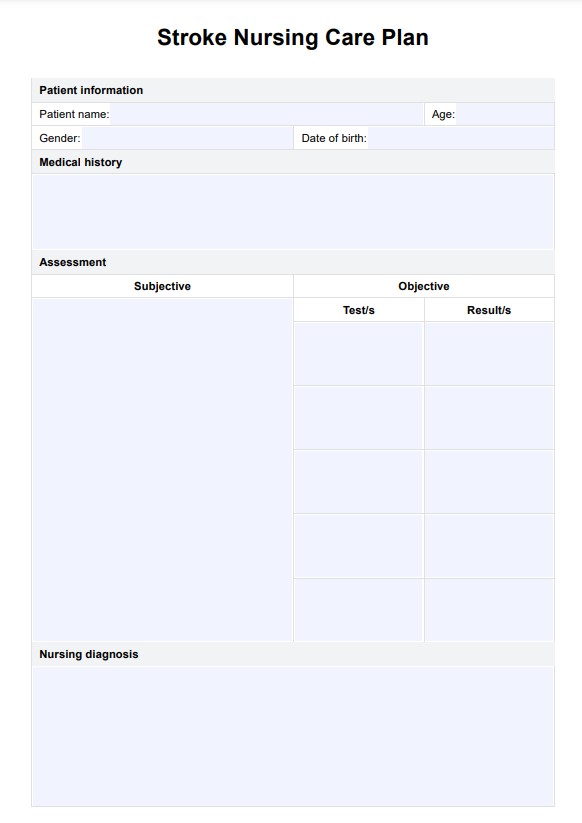Annual Check-Up Checklist
Ensure that your patient undergoes all the tests needed to evaluate their overall health with an Annual Check-Up Checklist. Click here for a free copy.


What is an Annual Check-Up Checklist?
An annual check-up is crucial to maintaining a patient's overall health and well-being. This comprehensive examination is a preventive measure that allows you to detect and address potential health issues early on. To ensure that your patient gets the most out of their annual check-up, following a well-structured checklist for annual physical exam is essential.
The following elements typically constitute a comprehensive Annual Check-Up Checklist:
- Vital signs evaluation: This is an assessment of vital signs, including core body temperature, heart rate, blood pressure, and respiration rate, among others. The values obtained are compared to age-appropriate standards to establish a baseline for your overall wellness.
- Visual and physical checks: To detect any signs of concern, a thorough visual and physical examination is conducted. This includes observing one's general appearance and response to physical activities to assess mobility. Other tests may also be requested to examine one's heart, lungs, abdomen, brain, ear, nose, throat, skin, and extremities.
- Sex-specific physical exams: Depending on the patient's gender, specific examinations are performed. For men, this may involve testicles, hernias, and prostate checks, while women undergo breast and pelvic exams.
- Laboratory screenings and tests: While not typically part of the annual physical, a checklist may also have essential screenings like complete blood count (CBC), blood chemistry, urinalysis, and other blood tests.
Aside from the elements mentioned above, a healthcare practitioner may also request updates on one's vaccine/booster and medical history and ask about one's lifestyle habits, past surgeries, medication, allergies, etc.
Annual Check-Up Checklist Template
Annual Check-Up Checklist Example
How does our Annual Check-up Checklist work?
To make the most of our Annual Check-up Checklist, follow the step-by-step instructions below.
Step 1: Acquire a template
Acquire a digital and printable Annual Check-up Checklist template, please follow one of the following methods:
- Select either the "Download Template" or "Use Template" button.
- Access Carepatron's template library on their website or app and search for the "Annual Check-Up Checklist."
Step 2: Fill out the template
Filling out the medical checkup checklist template is as simple as writing down information on their medical history, family health history, medical procedures, medication/allergies, symptoms, lifestyle habits, etc. Aside from those, you may also write down their vitals and tick off the tests they must undergo. It also has fields where you can write notes, findings, or remarks for each test.
This document may also double as a request form to show to laboratories as proof that the specific tests were requested.
Step 3: Ensure template security
After the patient's tests and once you've received the results of the requested tests, it is important to secure the Annual Physical Exam Template and restrict access to authorized individuals. We recommend using Carepatron, a free patient records software compliant with HIPAA standards, for secure and convenient digital storage.
When would you use this checklist?
Here are some instances when you might use this checklist:
Annual physical examination
The most common and anticipated use of the Annual Check-Up Checklist occurs during a patient's yearly visit to their healthcare provider. During this comprehensive evaluation, the healthcare professional will systematically review the annual physical exam checklist to examine all aspects of the patient's health thoroughly.
Health monitoring
If a patient has a chronic medical condition or is at an elevated risk for specific diseases due to family history or lifestyle choices, the referring physician may recommend more frequent check-ups. In these cases, the checklist is a recurring tool to monitor their health and promptly address emerging concerns.
Preventive care
Regular check-ups are crucial in preventive care. They proactively identify potential health issues before they escalate into major problems.
Updating treatments
The Annual Check-Up Checklist can serve as a benchmark for monitoring the progress of individuals undergoing treatment for a specific medical condition. It allows the referring physician to assess the patient's response to treatment and make necessary adjustments to their treatment plan.
Updating personal information
Keeping one's medical record up to date is essential. If one's lifestyle habits, such as smoking or alcohol consumption, occupational hazards, or family medical history have changed, the checklist provides a structured means of updating this crucial information during health screenings to check for any risk factors for medical conditions.
Commonly asked questions
You can create an Annual Check-Up Checklist by opening a document software and listing down all the pertinent information you need and tests a patient must undergo that can assist you in evaluating their overall health. Alternatively, you may download and use our Annual Check-Up Checklist template to save time and effort.
Annual Check-Up Checklists are used to request annual physical examinations, monitor one's condition, update treatment/personal information, and offer preventive care to the patient.
Annual Check-Up Checklists are created or, if using a template, filled out by general practitioners, family doctors, etc.














































































































